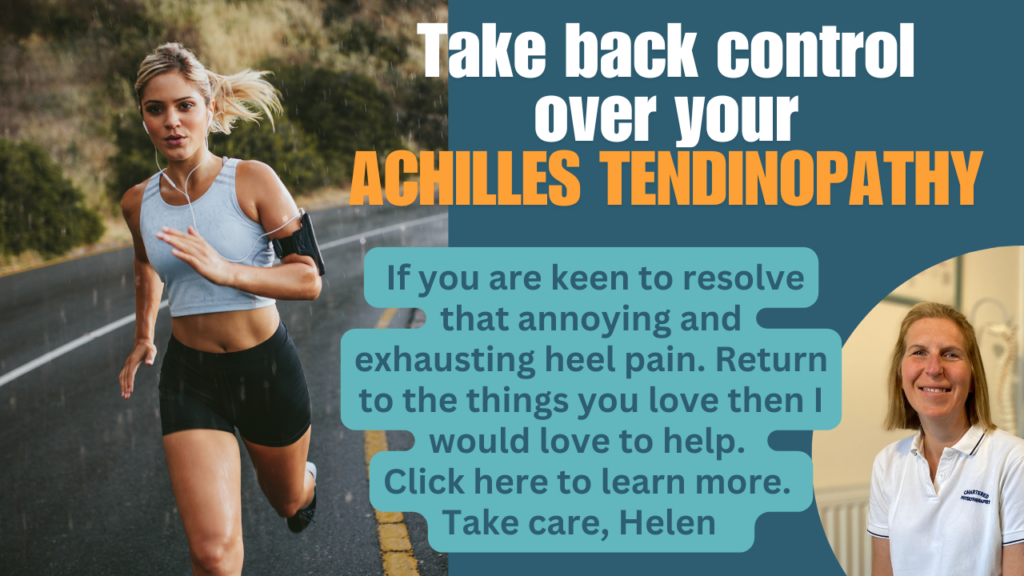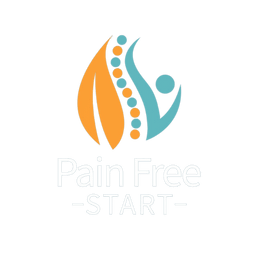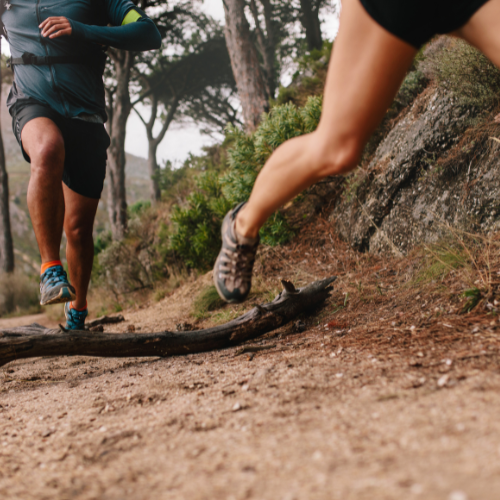The simple answer is quite possible – you can decide after reading this. 57% of runners will have Achilles Tendinopathy (previously known as Tendonitis) at some point, and many of those will get it recurrently. But when you look at how we load this tendon when we run it’s no surprise! This blog is a must-read for those runners who have got or had Achilles tendon problems. Here we look more at the role of the Achilles tendon in running and the loads absorbed during running before looking at what we can do to improve things.
Do I Need To Stop Running?
Don’t worry I’m not going to tell you ‘you can’t run’ – although initially, you may need a short break. Most importantly it’s about training smart. To do that you need a good awareness of what’s going on – after all knowledge is power!
Achilles Tendinopathy/Tendonitis
When it comes to tendon health it is all about load. Achilles tendinopathy is caused by an over or underloading of the tendon resulting in degenerate changes and poor tendon health. This more recent change in our understanding of the cause has really helped improve the way we treat this problem. We are no longer treating what we thought was inflammation (tendonitis) but focusing on managing load – of which there is a lot to manage when running. It’s not just runners that absorb and generate great loads it’s also the jumping athletes who play tennis, netball, and basketball to name but a few. Want to know more details about Achilles tendinopathy? Not sure if you have Achilles Tendinopathy? – Find out here.
What happens during a 10km run?
Let’s have a look at an average 10km run – completion time of 50 mins, with a cadence of 150. This works out to be 7500 steps in total – 3750 per leg. When we look at the forces involved this equates to 1.7 million kg! being absorbed through each leg – now that’s a crazy amount and certainly gave me a greater respect for this often forgotten but essential component of running.

FREE MASTER CLASS – Join me and find out if you have Achiiles Tendinopathy/ Tendonitis?
It’s all about load
Remember the cause of Tendinopathy is the over or underloading of a tendon! As a runner or athlete, you are not likely to be underloading the tendon, although we do see this in athletes who have been unwell or inactive for some time. However, for the active population, it’s going to be overload that creates the problem.
This is easily done especially if you are training for an event. Let’s say you decide to start by running an extra 1km – no big deal for you but have you asked your Achilles tendon its opinion on that extra km? That extra 1 km puts an extra 170000 kg through each Achilles tendon! Maybe now you are starting to appreciate what’s involved.
So you’ve done the extra 1km and you feel good. You are pleased – so much so that you think you will do the same thing tomorrow. Maybe this isn’t the best idea when we think about what’s going on in the tendon. The 11km run increases the normal load your tendon is used to, so it naturally responds with a release of chemicals that cause a reduction in collagen for 24-36 hours.
Training smart
So we have 3 options, 2 smart – 1 not so smart! Which do you choose?
Option 1 (SMART) – As we understand that our tendon is recovering for the next day or so we decide to use this as a rest day.
Option 2 (SMART) – We understand that although we don’t need to have a rest day that is a smart option instead we choose to do a short run, jump on the bike or head down the pool allowing us to exercise without further overloading the tendon. This allows the tendon to naturally recover before planning another 11km run later in the week.
This gradual increase in loading in these 2 options makes the tendon stronger, more robust, and more able to absorb load, which is exactly what you need when training for an event.
Option 3 (Not so SMART) – After smashing it the day before you head out again for another 11km run even considering trying 12km. The next day your tendon is stiff and tender when running, this eases off 10 minutes into the run so you think it’s okay. Unbeknown to you have just started the cycle of poor tendon health (tendinopathy).
It is that easy to get it wrong!

FIND OUT HOW TO IMPROVE YOUR ACHILLES TENDON – Click here to learn more.
Loading program
If you have got Achilles tendinopathy and you’ve done you’re research which as runners we are very good at! – then I imagine you have already tried a loading program in an attempt to resolve the problem. But if only it was this simple you would not be reading this now. Because it’s all about balance and load management. To strengthen and regain tendon health you MUST load the tendon, but too much load and make the problem worse. Find out more about eccentric loading an essential part of tendon rehab.
Don’t forget Soleus!
It’s also essential that we don’t forget the role of the soleus muscle which often gets forgotten about in loading programs in favor of its bigger and better-known calf friend the gastrocnemius (gastrox) muscle. When running these 2 calf muscles generate 11x body weight in intramuscular forces with each step! Now with the gastrox muscle being much larger, you would think that it did more of the work. This much smaller soleus muscle generates 8x body weight in intramuscular forces compared to gastrox generating only 3x body weight forces!
Yet most loading programs just load the gastrox!
Conclusion
So do you think your running is contributing to your pain?
If nothing else I’m sure you now all have much greater respect for this unsung running hero. Maybe you have started to see why you may be struggling to settle this problem. It’s certainly a tricky one and one that isn’t just about stopping running for a week and doing some loading exercises. Here I have just covered a few of the elements that are essential for runners to combine into their Achilles tendon rehab.
Don’t worry! – I’ve got it ALL covered in my Achilles Tendinopathy Program. Where I guide you step by step through a complete rehab program. Phase 1 – I show you how to quickly settle down the acute pain and symptoms. You will complete a lower limb biomechanics assessment and look at other risk factors that may have contributed to the problem, before correcting anything we find. Phase 2 – a complete rehab program incorporates ALL the loads your tendon needs to manage to return to running and prevent the problem from reoccurring.
Sounds good. Get started today and you will be back up and running in no time.
Take care, Helen
Helen Manders BSc (Hons) MCSP, HCPC,
Chartered Physiotherapist
Treating Achilles Tendons Since 2001



